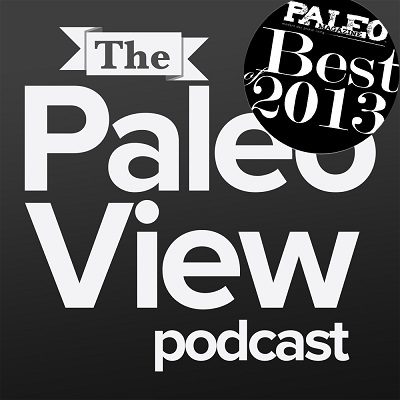Ep. 181, Common Health Questions
On this episode of The Paleo View, Stacy and Sarah tackle some of the most common health questions; topics that have nuggets of information for both long-time Paleo people and those new to this lifestyle.
Click the picture above to be taken to iTunes
or download and listen by clicking the PodBean Player below
![]()
If you enjoy the show, please review it in iTunes!
The Paleo View (TPV), Episode 181, Common Health Questions
- Intro (0:00)
- News and Views (0:56)
- Stacy started aerial yoga, see the video here
- And loved it so much she bought a system for home, the Aerial Essentials yoga fly kit
- All the love Sarah is sending to Stacy from the podcast licensers she met at her book signing events in Texas
- How loved Sarah felt during her Texas stops, and especially by those who brought her AIP friendly food to enjoy during her hectic travels
- What else Sarah did during her trip
- When Sarah returned home, she had a busy Monday morning appearing on a local news station to help with the opening of a new Sprouts location
- How Matt and Stacy eliminated their weekly stops to multiple grocery stores
- For this week’s show, we have a number of questions in the queue that are pretty general, but very common and will make for a great discussion for both those new to Paleo and those who have been following this template for a long time
- Stacy started aerial yoga, see the video here
- Science with Sarah (15:57)
- An article published in the scientific journal Nature, Diet Induced Extinctions in the Gut Microbiota Compound Over Generations
- The study asked the simple question – what happens to the gut micro biome when we go on a low fiber diet?
- The standard american diet is a low fiber diet
- What happens over the long-term
- Are the results reversible
- What happens from one generation to the next since we inherit our parents micro biome
- The gut micro biome refers to the collection of microbes living in our digestive track
- We have as many cells in our gut as we have in our whole body, if not double
- We depend on this bacteria that lives in our gut – they help us digest our food, access nutrients from our food, create nutrients from our food, regulate the immune system, regulate our metabolism, they regulate our gut barrier, they regulate our neurotransmitters, they impact every system in our body
- Every chronic illness is linked back to something going wrong with the bacteria in the gut
- What makes for a healthy gut micro biome is one with a large variety of different types of species that live in our gut
- We achieve this by eating a fiber rich diet from veggies, fruit, nut and seeds – and focusing on big portions of non-starchy vegetables with as much variety as possible
- Too high of fat can mess with the type of bacteria that grows in our body
- What the study did to explore the questions surrounding a low fiber diet
- And what the study found when studying a low fiber diet in mice
- They then looked at what happened over the course of four generations of high-fiber diets vs. low-fiber diets, and switching on an off between the two
- The paper emphasized that if we don’t fix the food system, we are not going to be able to recover human health because how linked our health is with this diversity of the gut micro biome
- Essentially bacteria extinction is taking place
- Not just a SAD is to blame for these changes, low carb and ketogenic diets are also low fiber and they also happen to be high fat
- Why emphasis on getting more vegetables is critical
- The daily recommended allowance of fiber is 25 g
- Aim for 9 to 14 servings of vegetables with a mix of starchy or non
- You can use an app like CRON-O-Meter to track your fiber intake
- The value that journaling for a couple of days can play in your overall health
- Eat more vegetables, look for great sources of probiotics, don’t regret the things you have done in the past
- Questions & Answers (34:54)
- Mary – can you overdo fiber?
- Generally the answer is no, but there is a big but to the answer
- Bacteria help us breakdown fiber – when we don’t have the right types of bacteria to help us breakdown that fiber it can cause gastrointestinal symptoms
- We can see these symptoms not only when fiber intake is too high, but when we are trying to increase our fiber intake, or reintroduce fiber after a SIBO approach where we are starving bad bacteria
- Slowly increase fiber if you are experiencing trouble, as opposed to automatically focusing on the 25 g a day – monitor GI symptoms, and pull back if you experience uncomfortable side effects
- Glenda – what are the best numbers to pay attention to for general health? What questions should I be asking my doctor during my annual physical?
- Stacy notes that it depends on your doctor – that it may work best for you to know ahead of time what you are looking to gain from your yearly physical and ask for tests relevant to those specific questions
- Stacy shared on the numbers that were most important to her to explore, and why those numbers were specific to her health and what she was dealing with
- Stacy’s general recommendations on numbers is to look into triglycerides, HGL, LDL, and blood sugar
- Sarah notes that all of the general tests that your doctor will run are excellent, but she recommends to be educated on the reference numbers
- If you think you have a problem with a particular system, that is where requesting more detailed testing is useful, but if you are monitoring how things are going, the usual tests will suffice
- Kimberly – are there some general guidelines to Paleo to follow?
- The general guidelines that Stacy follows:
- She values nutrients and focuses on where she is going to get her nutrients for the day, and she does monitor both calories and macros
- She thinks ahead through the day and how to achieve a balance that supports her health goals
- She makes sure she is going to get organ meat a couple of times a week, which Stacy gets through EPIC’s Liver Bites
- She also makes sure that she is getting seafood and broth a few times a week
- These guidelines may be a little overwhelming to someone who is fairly new to Paleo – a better way to look at it would be, is this the most healthy thing I can eat or does it simply taste good?
- Also consider your core food groups – get in the habit of eating meat and vegetables
- Your best approach is to practice moderation with your macro intake – 20/30% protein, 25/40% carbs, 30/55% fat
- Going with 1/3, a 1/3, 1/3 and letting things fluctuate a bit here an there from one day to the next will ensure balance
- 1/4 of your plate should be protein, with maybe 1 starchy vegetable and a couple of non-starchy vegetables
- Keep a food journal, be mindful, and make sure your caloric intake isn’t through the roof
- How Stacy has calculated her macros and how she adjusted them to tackle her specific health goals
- How Sarah gets her macros and the value she has found from journaling
- How tracking has impacted both Stacy and Sarah’s mental and physical health
- The general guidelines that Stacy follows:
- Mary – can you overdo fiber?
- The next Go to Bed group challenge starts this Sunday (learn more about this program on this podcast episode or visit the site HERE)
- Stacy encourages everyone to get in on handstand month
- Make sure you are signed up for both Stacy and Sarah‘s newsletters to not miss all the amazing posts and recipes that are going out!
- Thank you everyone for submitting your votes for Paleo Magazine Best of 2015!!
- And please don’t forget to leave a review for The Paleo View
- Thanks everyone!
- Outro (1:12:17)





